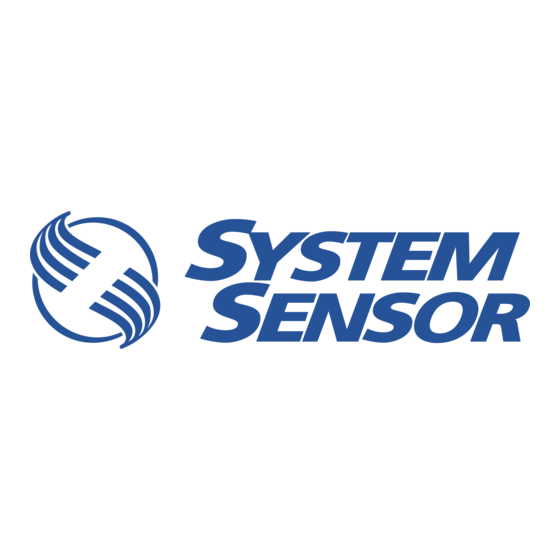Advertisement
INSTALLATION AND MAINTENANCE INSTRUCTIONS
B224BI Plug-in Isolator
Detector Base
SPECIfICATIONS
Base Diameter:
Base Height:
Mounting:
Operating Temperature Range:
Operating Humidity Range:
Electrical Ratings
Operating Voltage:
Standby Current:
Alarm Current:
Relay Contact Rating:
BEfORE INSTALLINg
Please thoroughly read the system wiring and installation manuals and the
System Smoke Detectors Applications Guide, which provides detailed informa-
tion on detector spacing, placement, zoning, and special applications.
NOTICE: This manual should be left with the owner/user of this equipment.
IMPORTANT: The detectors used with these bases must be tested and main-
tained following NFPA 72 requirements. The detectors used with these bases
should be cleaned at least once a year.
gENERAL INfORMATION
Isolator bases prevent an entire communications loop from being disabled
when a short circuit occurs. They accomplish this by isolating that part of the
loop containing the short from the remainder of the circuit. These bases also
automatically restore the entire loop when the cause of the short circuit is
corrected. In general, up to 25 addressable devices may be isolated between
isolator bases.
MOUNTINg
The detector base mounts directly to 3
square boxes, with or without a plaster ring. To mount, remove the decorative
ring by rotating it in either direction to unhook the snaps. Then, separate the
ring from the base. Install the base on the box, using the screws supplied with
the junction box and the appropriate slots in the base. Replace the decorative
ring on the base and rotate it in either direction until the ring snaps in place
(see Figure 1).
fIgURE 1. MOUNTINg BASE TO ELECTRICAL BOx:
D450-15-00
6.1˝ (155 mm)
1.2˝ (31 mm)
4˝ square box with or without plaster ring, Minimum Depth - 1.5˝ (38 mm)
4˝ octagon box, Minimum Depth - 1.5˝ (38 mm)
3
1
⁄
˝ octagon box, Minimum Depth - 1.5˝ (38mm)
2
14°F to 140°F (–10°C to 60°C)
NOTE: Do not install in locations where normal ambient temperature extends beyond 32°F to 120°F (0°C to 49°C)
10% to 93% Relative Humidity Non-condensing
15 to 32 VDC
450µA Maximum
5mA Maximum
2A at 30VDC/0.5A @ 125VAC (Resistive); 1A @ 30VDC/0.25A @ 125VAC (Inductive)
1
⁄
- and 4-inch octagon and 4-inch
2
SNAP ON
DECORATIVE
RING
SCREWS
(NOT SUPPLIED)
DETECTOR
BASE
BOX
(NOT SUPPLIED)
C1008-00
INSTALLATION gUIDELINES
All wiring must be installed in compliance with all applicable local codes and
any special requirements of the local authority having jurisdiction, using the
proper wire sizes. The conductors used to connect smoke detectors to control
panels and accessory devices should be color-coded to reduce the likelihood
of wiring errors. Improper connections can prevent a system from responding
properly in the event of a fire.
For signal wiring (the wiring between interconnected detectors), it is recom-
mended that the wire be no smaller than 18 gauge (0.9 square mm). However,
wire sizes up to 14 gauge (2.0 square mm) can be used with the base. The
use of twisted pair wiring or shielded cable for the power (+ and –) loop is
recommended to minimize the effects of electrical interference.
If shielded cable is used, the shield connection to and from the detector must
be continuous by using wire nuts, crimping, or soldering, as appropriate, for
a reliable connection.
Alarm system control panels have specifications for allowable loop resistance.
Consult the control panel specifications for the total loop resistance allowed
before wiring the detector loops.
Check the zone wiring of all bases in the system before installing detectors.
This includes checking the wiring for continuity, correct polarity, ground fault
testing, and performing a dielectric test.
1
3825 Ohio Avenue, St. Charles, Illinois 60174
1.800.SENSOR2; Fax: 630.377.6495
www.systemsensor.com
I56-0725-012R
Advertisement
Table of Contents

Summary of Contents for System Sensor B224BI
- Page 1 INSTALLATION AND MAINTENANCE INSTRUCTIONS B224BI Plug-in Isolator 3825 Ohio Avenue, St. Charles, Illinois 60174 1.800.SENSOR2; Fax: 630.377.6495 Detector Base www.systemsensor.com SPECIfICATIONS Base Diameter: 6.1˝ (155 mm) Base Height: 1.2˝ (31 mm) Mounting: 4˝ square box with or without plaster ring, Minimum Depth - 1.5˝ (38 mm) 4˝...
- Page 2 Please refer to insert for the Limitations of Fire Alarm Systems ThREE-YEAR LIMITED WARRANTY System Sensor warrants its enclosed air duct smoke detector to be free from defects in Sensor, Returns Department, RA #__________, 3825 Ohio Avenue, St. Charles, IL 60174.












Need help?
Do you have a question about the B224BI and is the answer not in the manual?
Questions and answers